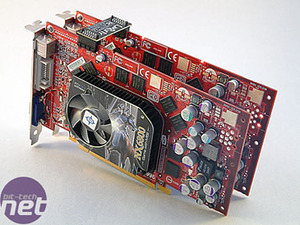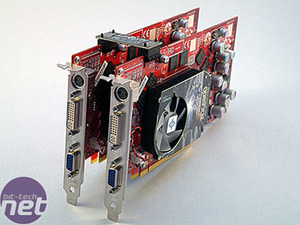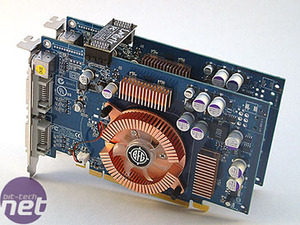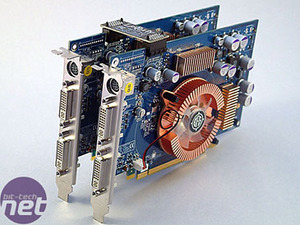So far, we have mainly focused our efforts on the high-end solution that SLI is often perceived as. However, NVIDIA's GeForce 6600 GT - a very popular mainstream video card right now - has support for NVIDIA's SLI. This brings SLI to the mainstream, and to people who cannot afford to just drop £700 on their next big upgrade. It's possible to buy an SLI motherboard and video card combination for around £400. That's quite a big difference in price, and we're here to evaluate that sector of the video card market today.
The GeForce 6800 Std is an option that some may consider too - it's not quite as fast as GeForce 6800 GT's but it is a lot more affordable, with cards priced around the £200 mark. However, unlike the GeForce 6800 Std on AGP, this is not based on the same GPU as the GeForce 6800 GT. The GeForce 6800 Std on PCI-Express uses NVIDIA's NV41 chip, which only has twelve pixel pipelines and five vertex shaders. There are no additional pipelines or shaders to unlock, so modders looking for the ultimate bargain are out of luck.

 MSI's GeForce 6800 Std comes with a massive bundle, much like what we've seen before with their Radeon X800 XL. The card itself comes with a familiar heatsink design - it's the same as the design that can be found on many GeForce 6600 GT's. The card comes clocked at 325/700MHz and features 256MB of BGA-type DDR1 memory. The card operates entirely on power supplied to it via the PCI-Express x16 interconnect, which may please some users who don't like the idea of two power connectors running down to connect to their video cards.
MSI's GeForce 6800 Std comes with a massive bundle, much like what we've seen before with their Radeon X800 XL. The card itself comes with a familiar heatsink design - it's the same as the design that can be found on many GeForce 6600 GT's. The card comes clocked at 325/700MHz and features 256MB of BGA-type DDR1 memory. The card operates entirely on power supplied to it via the PCI-Express x16 interconnect, which may please some users who don't like the idea of two power connectors running down to connect to their video cards.
In general, we found that the heatsink got rather loud in SLI when gaming, but it didn't seem to have the same problems when we used one card on its own. However, it was quiet when we were not stressing the card during games. Our test bed is an open bench with the cards at eye level, so the noise of these cards could well be amplified by that fact. A typical end user would have these cards in a closed case, and the noise of these cards during gaming is likely to be muffled by the case, and also by the music or sound effects from the game.

 We have already looked at BFGTech's GeForce 6600 GT OC in a single card configuration, where we awarded it bit-tech.net's award for excellence. The card is slightly overclocked compared to a typical GeForce 6600 GT, running at 525/1050MHz. Again, the card operates entirely on power supplied to it via the PCI-Express x16 interconnect.
We have already looked at BFGTech's GeForce 6600 GT OC in a single card configuration, where we awarded it bit-tech.net's award for excellence. The card is slightly overclocked compared to a typical GeForce 6600 GT, running at 525/1050MHz. Again, the card operates entirely on power supplied to it via the PCI-Express x16 interconnect.
The cooler is a copper one, and there are also copper heatsinks on the 128MB of GDDR3 memory. The cooler on the GPU emits a nice cool blue glow when the system is turned on, and we did not experience any unwanted noise from the fan during heavy load. This was also the case when two were placed side by side for SLI. This was the quietest SLI solution of the four different video card combinations, so if noise is more important than performance, this is where your eyes should be focused.
Yesterday, we covered enabling SLI and how the two different SLI rendering profiles work, so we will assume that you have already read that article. If you have not, you can find it over here.
The GeForce 6800 Std is an option that some may consider too - it's not quite as fast as GeForce 6800 GT's but it is a lot more affordable, with cards priced around the £200 mark. However, unlike the GeForce 6800 Std on AGP, this is not based on the same GPU as the GeForce 6800 GT. The GeForce 6800 Std on PCI-Express uses NVIDIA's NV41 chip, which only has twelve pixel pipelines and five vertex shaders. There are no additional pipelines or shaders to unlock, so modders looking for the ultimate bargain are out of luck.


In general, we found that the heatsink got rather loud in SLI when gaming, but it didn't seem to have the same problems when we used one card on its own. However, it was quiet when we were not stressing the card during games. Our test bed is an open bench with the cards at eye level, so the noise of these cards could well be amplified by that fact. A typical end user would have these cards in a closed case, and the noise of these cards during gaming is likely to be muffled by the case, and also by the music or sound effects from the game.


The cooler is a copper one, and there are also copper heatsinks on the 128MB of GDDR3 memory. The cooler on the GPU emits a nice cool blue glow when the system is turned on, and we did not experience any unwanted noise from the fan during heavy load. This was also the case when two were placed side by side for SLI. This was the quietest SLI solution of the four different video card combinations, so if noise is more important than performance, this is where your eyes should be focused.
Yesterday, we covered enabling SLI and how the two different SLI rendering profiles work, so we will assume that you have already read that article. If you have not, you can find it over here.

MSI MPG Velox 100R Chassis Review
October 14 2021 | 15:04






Want to comment? Please log in.